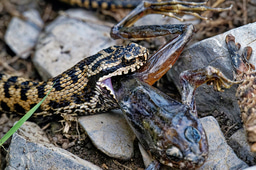A new article examines hyoid musculature of chameleons to explain their extreme length change.

🦎A new article examines hyoid musculature of chameleons to explain their extreme length change.

👩🔬The authors found that one muscle represents the second known supercontracting muscle among vertebrates (the first being the tongue retractor muscle in chameleons), with perforated sarcomere z-discs allowing for the muscle to exert forces over a broader range of muscle lengths than typical striated muscle is capable of.
👅The second exhibits a similarly broad force-length relationship, but does so with uninterrupted z-discs, indicating that it achieves this result through another means.
👩🔬The authors propose that it does so through sarcomere length non-uniformity and that the supercontracting muscles of chameleons may share common contractile and structural properties due to a common origin from occipital somites.
👉 If you want more information, I encourage you to read the references:
Schneider Nikole G., Henchal Nicholas A., Diaz Jr Raul E. and Anderson Christopher V. 2025Feats of supercontractile strength: functional convergence of supercontracting muscle properties among hyoid musculature in chameleonsProc. R. Soc. B.29220250078
https://doi.org/10.1098/rspb.2025.0078
More interesting facts from the world of herpetology on my new page:
https://www.facebook.com/profile.php?id=61573408584356
Courtesy of IUCN SSC Chameleon Specialist Group
#cameleon #tongues #anatomy #lizards #sauria #nature #herpetology





Please sign in or register for FREE
If you are a registered user on WildHub, please sign in